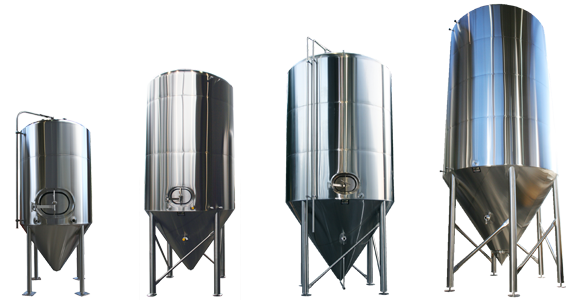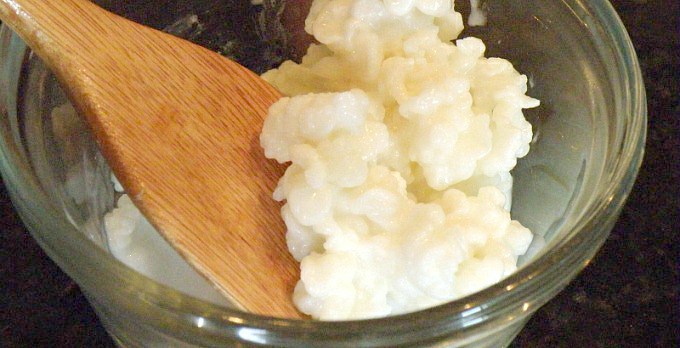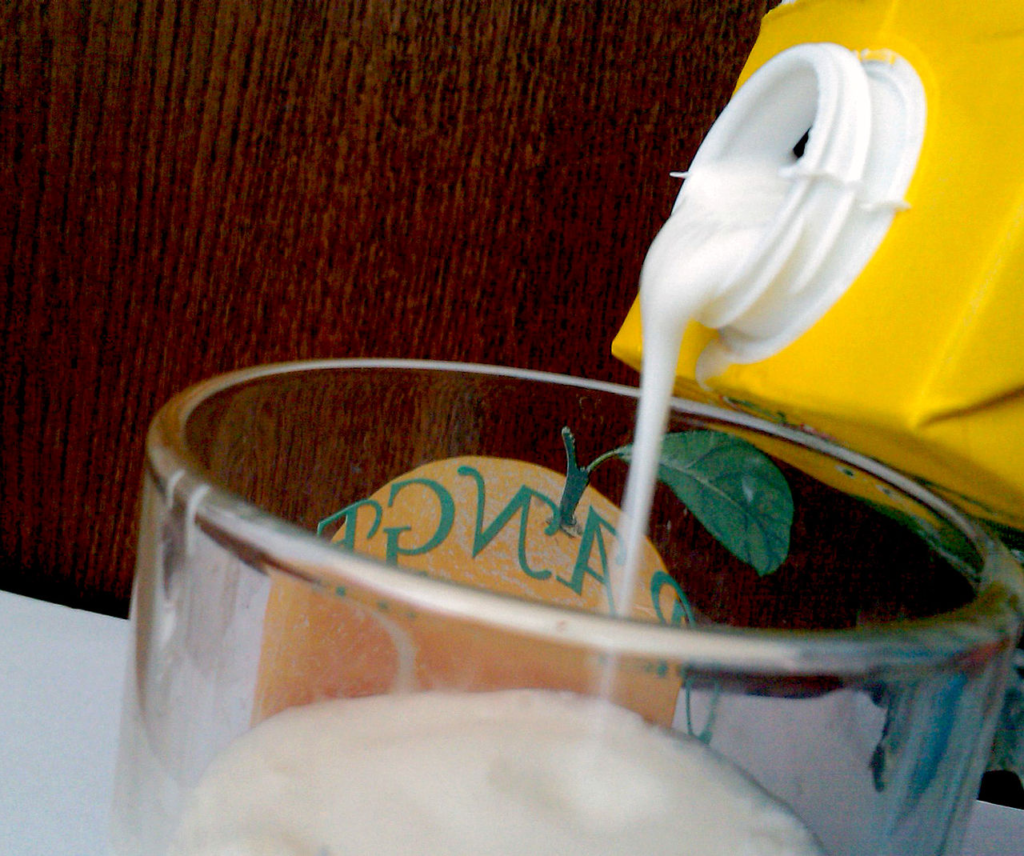Yogurt, such as the raw vegan almond yogurt shown below, and kefir are fermented milk products. Their fermentation and production encompass many chemical engineering processes.
The process begins with milk pasteurization. After milk is brought to the plant, it is heated to kill off unwanted microbial organisms. The milk is then brought to a fermentation tank, where lactic acids create familiar flavor profiles. Kefir undergoes one additional fermentation step involving kefir grains. More flavors can then be added, after which the product is packaged and kept cool until it is shipped.
Ingredient Preparation
Milk is shipped to the yogurt plant, where it is stored at 7 °C or cooler. It is then carefully pasteurized to kill off any unwanted or harmful microbes
Pasteurization
Industrial pasteurizers contain three compartments: Preheat, final-heat, and cooling. Normally a plate and frame heat exchanger, pictured below, is used at medium pressures to heat the milk up to a proper temperature, with water as the heating medium. Note that the two streams do not mix in the heat exchanger – Heat is transferred from the water to the milk across the metal panels in the heat exchanger,
High-temperature short time (HTST) pasteurization is the most typical form of pasteurization. Most industrial-size HTST pasteurizers have a target temperature of 70 °C with a hold time of 20 seconds, where the hold time is how long the milk is kept at the specified temperature. Alternatively, ultra-heat treating (UHT) brings the milk up to 135 °C for a hold time of two seconds. For safety purposes, it is favorable to heat the milk longer, but that can leave it tasting burnt. Leaving the milk at elevated temperatures for long periods of time could also denature the proteins, which could upset the curd bonding process later. Pasteurization planning focuses on optimizing for all these considerations. Spray cooling must be used to quickly cool the milk after pasteurization. It is very important to get the milk down to a low temperature as soon as possible to keep bacteria growth to a minimum. After pasteurization, the cooled milk goes to a fermenting tank. This is the point where cheese and other fermented milk products diverge.
Production
Fermentation
Lactic Fermentation
Unlike cheese production, where milk undergoes aerobic fermentation, to make yogurt and kefir anaerobic fermentation is used. This means yogurt and kefir go through fermentation without the presence of oxygen. Keeping oxygen away from the process allows the bacteria to focus solely on the fermentation of lactic acid. With oxygen, the bacteria would produce unwanted by-products. To begin the incubation period, bacteria that eat the lactose to produce lactic acid are added to the fermenter. The tank is then closed off from the environment so that oxygen will not affect the fermentation. Since the fermentation is creating an acid, the pH of the fermented milk product will go down, which helps prevent spoilage. Fermentation continues until the desired acidity is reached. The milk product will also thicken as fermentation occurs.
Kefir goes through a slightly different fermentation than yogurt. During its incubation period, kefir goes through a yeast acid fermentation in addition to lactic fermentation.
Yeast Fermentation of Kefir
Kefir is named for the porous kefir grains used in the fermentation of the milk product. Yeast eats away at the grain during fermentation to produce new compounds that add to the flavor profile of kefir. After fermentation, the kefir has a similar consistency to cottage cheese as seen in the picture below.
Fermentation produces a yeasty aroma similar to that of bread and beer. During the fermentation, the primary product is carbon dioxide, which adds carbonation to the fermented milk beverage. In addition, kefir will have trace amounts of alcohol, esters, and ketones. In the United States, commercially produced kefir has a lot less alcohol and flavor compounds than in European countries due to federal regulations. The fermentation of kefir yeast is monitored intensely so as to meet federal alcohol regulations. After fermentation, the kefir grains are drained out so that they can be used again in the next incubation. The leftover liquid can then be sold as a kefir product.
Kefir can be flavored in similar ways to yogurt. The final Kefir is characteristically thinner than yogurt after it is strained and is primarily produced in the form of a beverage. It can be blended into a smoothie, strained to make it even thinner, or enjoyed without changing anything. The picture below shows a final kefir product.
Post-Fermentation Processing
Much like cheese, yogurt products can take on many shapes and have a range of particle sizes based on how the product is handled. Greek yogurt can be made by mechanical centrifugation, which creates a thicker, protein-dense product. In centrifuges, a centrifugal force, generated by high-speed rotations, is used to separate solids from liquids. Centrifugation can be used to recover solids from slurries, clarify liquids, or clarify solids. In the context of Greek yogurt, a yogurt product enters the machine. The water is then separated from the dairy because they are different densities and viscosities. The dairy is then collected as Greek yogurt.
Secondly, French yogurt is created by putting it through reverse osmosis to create a distinct yogurt with intermixed thick and watery textures. A pressure differential causes yogurt to filter through a semi-permeable membrane, typically made of cellulose acetate. Running the yogurt through the membrane concentrates the proteins and lactose in the yogurt. This creates a unique texture and taste. The protein-dense yogurt product can then be collected.
Yogurt products can be watered down and blended to create smoothies and drinks. Yogurt is also commonly paired with chocolate, fruit, spices, nuts, or a combination of flavors. Fruit is not added directly to yogurt because fruit in its natural form can house microbes and will spoil quickly. The fruit is instead processed into a jam by chopping it into pieces and placing it into a heated mixer with artificial coloring, sugar, and water. It is heated for some time to kill off any bacteria that may be present.
Packaging
Yogurt products are placed in airtight, plastic containers before they are shipped. The containers are wide so that the yogurt can be accessed with a spoon. Kefir is typically bottled in plastic or glass containers since it is a beverage. It is important to keep the products in an airtight container to prevent spoilage. Containers used to hold yogurt vary in size based on the quantity of yogurt needed. Common containers include single serving 6-ounce and larger 32-ounce containers. The bacteria culture is still alive in the yogurt, so after packaging some lactic fermentation still occurs.
Fruit is typically added to the yogurt container in 3 ways. Some containers have two separate compartments, one for fruit and one for yogurt. The most typical way to add fruit jam is by placing a fixed amount at the bottom of the container and then placing the yogurt directly on top. In some cases, the fruit is placed in the yogurt and blended to create a uniform mixture. Other flavoring agents are processed and added to yogurt in the same way as fruit.
Based on when the yogurt is fermented, the factory places a “best by” date and allergy information on the yogurt containers. In addition, the factory making the yogurt must place its name on the packaging. After a full inspection, the yogurt is placed in a refrigerated shipping container and brought to designated grocers for individual sale.
Quality Control
Within 96 hours of pasteurization, the yogurt product must be cooled to 7 °C so that outside bacteria cannot integrate into the product. Its pH must be 4.8 after fermentation, and 4.6 or lower within 24 hours. This ensures the product will have the proper flavor and prevents the growth of any extra bacteria. Yogurt production must be handled with care if there are nuts and other potential food allergens used during the process so as to not contaminate any of the product. Yogurt made at a factory will typically use ingredients with similar allergy characteristics so as to not contaminate it, which could result in an allergic reaction in a yogurt that is not supposed to contain that allergen. To uphold these standards, yogurt is tested rigorously by quality engineers during the entire yogurt production process. If the pH standards were not met, yogurt could vary in its flavor as well as its expiration date.
Acknowledgments
- JVNW, Canby, OR
- Alfa Laval, Richmond, VA
- By Saúde em dia, Douglas Medrado, Alan Costa – https://www.saudedia.com.br/kefir/, CC BY-SA 4.0
- Todoran, I. (2010). Raw vegan almond yogurt [Photograph]. Retrieved from https://flic.kr/p/7L8ELK
- Wikimedia Commons: Kefir Pouring
References
- CFR – Code of Federal Regulations Title 21 (2019, April 9). In U.S. Food and Drug Administration.
- Chandan, R. C., & Kilara, A. (2013). Manufacturing Yogurt and Fermented Milks . N.p.: John Wiley & Sons, Incorporated.
- Verce, M., De Vuyst, L., & Weckx, S. (2019). Shotgun Metagenomics of a Water Kefir Fermentation Ecosystem Reveals a Novel Oenococcus Species. Frontiers in microbiology , 10 , 479. doi:10.3389/fmicb.2019.00479
Developers
- Austin Potter
- Tamia Middleton





